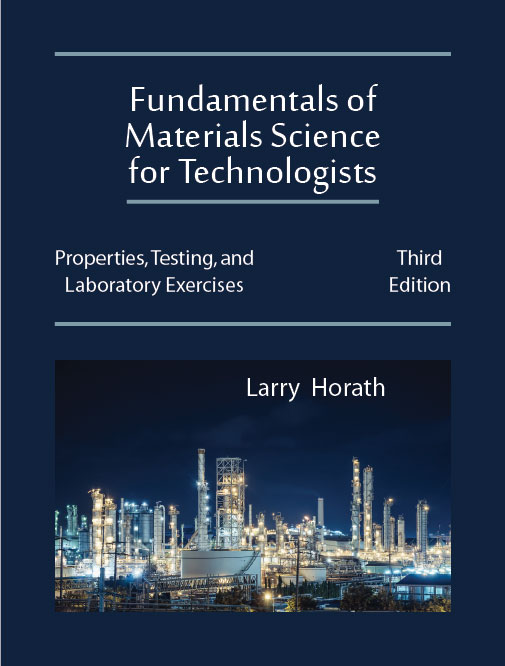Section One: FUNDAMENTALS OF MATERIALS TECHNOLOGY
1. Introduction to Materials Technology
Introduction / Atomic Theory / Bonding of Materials / Crystalline Structures / Specification of Materials / Standards Organizations / Summary
2. Ferrous Metals
Introduction / Production of Iron / Production of Steel / Carbon Content in Steels / Other Elements in Steels / Nomenclature of Steels / Tool Steels / Cast Iron / Stainless Steels / Corrosion / Summary
3. Nonferrous Metals
Introduction / Aluminum / Chromium / Copper, Brass, and Bronze / Magnesium / Nickel / Precious Metals / Refractory Metals / Titanium / White Metals: Lead, Tin, and Zinc / Summary
4. Heat Treatment
Introduction / Iron-Carbon Phase Diagrams / Time-Temperature Transformation Curves / Methods of Softening Steels / Methods of Hardening Steels / Surface Hardening / Heat Treatment of Other Metals / Summary
5. Polymers and Elastomers
Introduction / Polymeric Structure / Mechanisms of Polymerization / Properties of Polymers / Manufacturing Processes Involving Polymers / Natural Resins / Thermosetting Materials / Thermoplastic Materials / Liquid Crystal Polymers / Reinforced Polymers / Elastomers / Summary
6. Wood and Wood Products
Introduction / Types and Properties of Wood and Lumber / Physical and Mechanical Properties of Wood / Classification and Grading of Lumber / Plywood, Reconstituted Wood Panels, Modified Woods, and Their Applications / Preservatives / Paper and Cardboard / Summary
7. Ceramics and Glass
Introduction / Ceramics / Glass / Types and Properties of Stone / Types and Properties of Clay / Types and Properties of Refractory Materials / Abrasives / Summary
8. Cement, Concrete, and Asphalt
Introduction / Manufacture of Portland Cement / Concrete / Reinforced and Prestressed Concrete / Concrete Additives / Asphalt and Asphaltic Concrete / Summary
9. Composites
Introduction / Types of Composites / Nanocomposites / Composite Construction / Fabrication / Summary
10. Adhesives and Coatings
Introduction / Adhesives / Coatings / Summary
11. Smart Materials
Introduction / Piezoelectric Materials / Rheological Fluids / Shape Memory Alloys and Shape Memory Polymers / Applications / Summary
12. Fuels and Lubricants
Introduction / Types of Fuels / Combustion and Burning / Coal / Petroleum / Gaseous Fuels / Types and Properties of Lubricants / Summary
Section Two: PRINCIPLES OF MECHANICAL AND NONDESTRUCTIVE TESTING
13. Mechanical Behavior
Introduction / Fundamental Mechanical Properties / Mechanical Test Considerations / Testing Conditions / Stress and Strain / Stiffness / Stress-Strain Diagrams / Slip / Elasticity / Plasticity / Categories of Strength / Types of Failure / Energy Capacity / Summary
14. Introduction to Materials Testing
Introduction / Testing versus Inspection / Precision, Accuracy, and Significance of Tests / Collecting Data / Testing Procedures / Testing Machines / Test Instruments / Presentation of Results / Test Selection / Summary
15. Tensile Testing
Introduction / Principles / Equipment / Procedure / Expected Results / Variations on Standard Procedures / Summary
16. Creep Testing
Introduction / Principles / Equipment / Procedure / Expected Results / Summary
17. Compression Testing
Introduction / Principles / Equipment / Procedure / Expected Results / Summary
18. Shear Testing
Introduction / Principles / Equipment / Procedure / Expected Results / Summary
19. Bend or Flexure Testing
Introduction / Principles / Equipment and Procedures / Summary
20. Hardness Testing
Introduction / Principles / Equipment and Procedures / Comparison of Hardness Tests / Summary
21. Impact Testing
Introduction / Principles and Equipment / Procedures and Expected Results / Summary
22. Fatigue Testing
Introduction / Principles and Equipment / Procedures / Summary
23. Nondestructive Testing and Evaluation
Introduction / Radiography and Diffraction / Magnetic and Electromagnetic Methods / Ultrasonic and Acoustic Emissions Methods / Visual Methods and Holography / Photoelasticity / Liquid Penetrants / Summary
Appendix A: Sources of Further Information
Appendix B: Measurement and Properties of Materials
Appendix C: Laboratory Exercises
Appendix D: Glossary of Selected Terms
Appendix E: Answers to Selected Questions and Problems

536 pages, $87.95 list
1-4786-3769-2
978-1-4786-3769-1
© 2019
paperback
Instructor's resource materials available here
To obtain a username and password to access these materials, contact comps@waveland.com.
To obtain a username and password to access these materials, contact comps@waveland.com.
eBook availability
Fundamentals of Materials Science for Technologists
Properties, Testing, and Laboratory Exercises
Third Edition
The properties of materials provide key information regarding their appropriateness for a product and how they will function in service. The Third Edition provides a relevant discussion and vital examples of the fundamentals of materials science so that these details can be applied in real-world situations. Horath effectively combines principles and theory with practical applications used in today's machines, devices, structures, and consumer products. The basic premises of materials science and mechanical behavior are explored as they relate to all types of materials: ferrous and nonferrous metals; polymers and elastomers; wood and wood products; ceramics and glass; cement, concrete, and asphalt; composites; adhesives and coatings; fuels and lubricants; and smart materials.
Valuable and insightful coverage of the destructive and nondestructive evaluation of material properties builds the groundwork for inspection processes and testing techniques, such as tensile, creep, compression, shear, bend or flexure, hardness, impact, and fatigue. Laboratory exercises and reference materials are included for hands-on learning in a supervised environment, which promotes a perceptive understanding of why we study and test materials and develop skills in industry-sanctioned testing procedures, data collection, reporting and graphing, and determining additional appropriate tests.
Valuable and insightful coverage of the destructive and nondestructive evaluation of material properties builds the groundwork for inspection processes and testing techniques, such as tensile, creep, compression, shear, bend or flexure, hardness, impact, and fatigue. Laboratory exercises and reference materials are included for hands-on learning in a supervised environment, which promotes a perceptive understanding of why we study and test materials and develop skills in industry-sanctioned testing procedures, data collection, reporting and graphing, and determining additional appropriate tests.